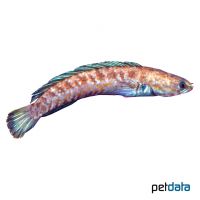Blue Snakehead (Channa andrao)
| Blue Snakehead Channa andrao | |
|---|---|
| Name | Blue Snakehead |
| Name Lat. | Channa andrao |
| Synonym | Channa sp. 'Blue bleheri' |
| Family | Snakeheads |
| Family lat. | Channidae |
| Order | Labyrinth Fishes |
| Order lat. | Anabantiformes |
| Origin | India |
| Habitat | Rivers, floodplains |
| Diet | Carnivore |
| pH | 6.5-8.0 |
| Behavior | Aggressive |
| Keeping | Individual, pair |
| Care Level | Moderate |
| Reproduction | Mouthbrooder |
| Breeding | Difficult |
| Life Span | N/A |
| Protection | No |
| Metric Units | |
| Size | 8-10 cm |
| Temperature | 18-28 °C |
| Hardness | 2-20 °dH |
| Aquarium | ~ 150 l |
| US Units | |
| Size | 3"-4" |
| Temperature | 64-82 °F |
| Hardness | 36-356 ppm |
| Aquarium | ~ 40 gal |
Distribution and habitat
The range of the Blue Snakeheads is exclusively the Brahmaputra river system in northeastern India (Assam). They live in shallow, slow-flowing waters and floodplains with dense underwater vegetation, hidden among roots, stones and fallen leaves
Maintenance
The aquarium should have dense planting, with many hiding places, such as caves (e.g. perforated rocks, clay tubes) and roots, as well as free swimming space. A dark sand substrate covered with some foliage (e.g. sea almond or beech leaves) and subdued light (floating plants) is ideal.
No ammonia, ammonium and nitrite should be detectable, the nitrate value should not exceed 100 mg/l. To ensure water quality and oxygen content, a filter and heater adapted to the aquarium size is required, as well as lighting for the species-appropriate day-night rhythm of the animals.
Diet
The food supply consists of live, frozen and dry food. For a balanced diet, feed once a day with a high-quality, protein-rich dry food (flakes, granules, pellets) as well as mosquito larvae, shrimp, mysis, small crabs, crab meat, etc. (live or frozen).
Only feed as much as will be eaten within a few minutes. A regular and varied diet promotes health and increases resistance
Behaviour and compatibility
Juveniles are compatible with each other, adults are aggressive within the species. In a larger tank, structured with many hiding places, pair keeping is also possible. They can be well socialized with calm, large fish
In principle, only mutually compatible fish species with similar demands on water quality and water temperature may be socialized.
Sex dimorphism
Males have longer dorsal and anal fins and iridescent blue coloration on the unpaired fins. Females are slightly reddish in color, slightly larger and rounder, especially at spawning time
Reproduction and breeding
They are mouth brooders. After spawning, the male takes the eggs into the mouth for brood care. After 3-5 days, sometimes much longer, the young hatch. Food is nutrient eggs produced by the female. The fry continue to be cared for by the parents for several weeks. The fry must be adequately fed with Drosophila, Artemia nauplii and Cyclops several times a day, otherwise they will eat each other.
In community tanks breeding is hardly possible, because the fry are easy prey.
Important
The Blue Snakeheads should not be kept at a constant temperature, natural seasonal variations (winter and summer periods) are better
The fish should not be offered meat of mammals (beef, pork) or poultry, because it contains certain lipids that can not be digested and therefore there may be fat deposits and even organ degeneration.
They have an additional respiratory organ, the so-called labyrinth (suprabranchial organ) with which they breathe atmospheric air and can suffocate if this is not possible
Since they like to jump, the aquarium must be well covered.
The well-being of the fish should be checked regularly. Temperature should be checked daily, pH, hardness and nitrate levels at least every 14 days. Regular partial water changes are recommended, even if the contaminant level has not yet reached the upper limit. Sudden changes in water quality should be avoided. Newly introduced fish must be accustomed slowly to the water in the aquarium.
Further literature can be found in your pet store.
References
Text: Werner Winter; Image: petdata
Source: BMELV (1998): Tierschutzgutachten - Haltung von Zierfischen (Süßwasser); ENGELMANN (2005): Zootierhaltung - Tiere in menschlicher Obhut: Fische; Harri Deutsch Verlag
- Gemäß § 21 Abs. 5 Tierschutzgesetz idgF
